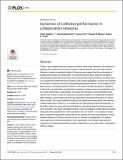Dynamics of collective performance in collaboration networks
Author(s)
Amelkin, Victor; Askarisichani, Omid; Kim, Young Ji; Singh, Ambuj K.; Malone, Thomas W
Downloadjournal.pone.0204547.pdf (6.574Mb)
PUBLISHER_CC
Publisher with Creative Commons License
Creative Commons Attribution
Terms of use
Metadata
Show full item recordAbstract
This is an open access article distributed under the terms of the Creative Commons Attribution License, which permits unrestricted use, distribution, and reproduction in any medium, provided the original author and source are credited. Today, many complex tasks are assigned to teams, rather than individuals. One reason for teaming up is expansion of the skill coverage of each individual to the joint team skill set. However, numerous empirical studies of human groups suggest that the performance of equally skilled teams can widely differ. Two natural question arise: What are the factors defining team performance? and How can we best predict the performance of a given team on a specific task? While the team members' task-related capabilities constrain the potential for the team's success, the key to understanding team performance is in the analysis of the team process, encompassing the behaviors of the team members during task completion. In this study, we extend the existing body of research on team process and prediction models of team performance. Specifically, we analyze the dynamics of historical team performance over a series of tasks as well as the fine-grained patterns of collaboration between team members, and formally connect these dynamics to the team performance in the predictive models. Our major qualitative finding is that higher performing teams have well-connected collaboration networks-as indicated by the topological and spectral properties of the latter-which are more robust to perturbations, and where network processes spread more efficiently. Our major quantitative finding is that our predictive models deliver accurate team performance predictions-with a prediction error of 15-25%-on a variety of simple tasks, outperforming baseline models that do not capture the micro-level dynamics of team member behaviors. We also show how to use our models in an application, for optimal online planning of workload distribution in an organization. Our findings emphasize the importance of studying the dynamics of team collaboration as the major driver of high performance in teams.
Date issued
2018-10Department
Massachusetts Institute of Technology. Center for Collective Intelligence; Sloan School of ManagementJournal
PLOS ONE
Publisher
Public Library of Science
Citation
Amelkin, Victor et al. “Dynamics of Collective Performance in Collaboration Networks.” Edited by Gustavo Stolovitzky. PLOS ONE 13, 10 (October 2018): e0204547 © 2018 Amelkin et al
Version: Final published version
ISSN
1932-6203